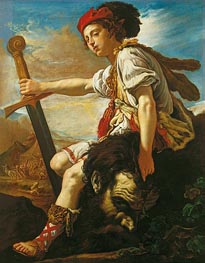Domenico Fetti Painting Reproductions 1 of 1
c.1589-1624
Italian Baroque Painter
Domenico Fetti (also spelled Feti, ca. 1589 - 1623) was an Italian Baroque painter active mainly in Rome, Mantua and Venice.
Born in Rome to a little known painter, Pietro Fetti, Domenico is said to have apprenticed initially under Ludovico Cigoli, or his pupil Andrea Commodi in Rome from circa 1604-1613. He then worked in Mantua from 1613 till around 1621-22, patronized by the Cardinal, later Duke Ferdinando I Gonzaga. In the Ducal Palace, he painted the Miracle of the Loaves and Fishes.
In 1621-22, due to some feuds with prominent Mantuans, he moved to Venice, which for the first few decades of the 17th century had persisted in mainly sponsoring Mannerist styles as epitomized by Palma the Younger and the successors of Tintoretto and Veronese. Into this mix, three "foreigners", Fetti and his younger contemporaries Bernardo Strozzi and Jan Lys, breathed in the 1620-30s, the first influences of Roman Baroque style. They adapted some of the rich coloration of Venice but adapted it to Caravaggio-influenced realism and monumentality.
In Venice, Fetti changed his style, and his formalised painting style became more pictorial and colourful. In addition, he devoted attention to smaller cabinet pieces that adapt genre imaging to religious stories. His group of paintings entitled Parables, which represent New Testament scenes, are at the Dresden Gallery.
His style appears to be influenced by Rubens. He would likely have continued to find excellent patronage in Venice had he not died there in 1623 or 1624. Jan Lys, eight years younger, but who had arrived to Venice nearly contemporaneously, died during the Plague of 1629-30. Subsequently, Fetti's style would influence the Venetians Pietro della Vecchia and Sebastiano Mazzone.
Born in Rome to a little known painter, Pietro Fetti, Domenico is said to have apprenticed initially under Ludovico Cigoli, or his pupil Andrea Commodi in Rome from circa 1604-1613. He then worked in Mantua from 1613 till around 1621-22, patronized by the Cardinal, later Duke Ferdinando I Gonzaga. In the Ducal Palace, he painted the Miracle of the Loaves and Fishes.
In 1621-22, due to some feuds with prominent Mantuans, he moved to Venice, which for the first few decades of the 17th century had persisted in mainly sponsoring Mannerist styles as epitomized by Palma the Younger and the successors of Tintoretto and Veronese. Into this mix, three "foreigners", Fetti and his younger contemporaries Bernardo Strozzi and Jan Lys, breathed in the 1620-30s, the first influences of Roman Baroque style. They adapted some of the rich coloration of Venice but adapted it to Caravaggio-influenced realism and monumentality.
In Venice, Fetti changed his style, and his formalised painting style became more pictorial and colourful. In addition, he devoted attention to smaller cabinet pieces that adapt genre imaging to religious stories. His group of paintings entitled Parables, which represent New Testament scenes, are at the Dresden Gallery.
His style appears to be influenced by Rubens. He would likely have continued to find excellent patronage in Venice had he not died there in 1623 or 1624. Jan Lys, eight years younger, but who had arrived to Venice nearly contemporaneously, died during the Plague of 1629-30. Subsequently, Fetti's style would influence the Venetians Pietro della Vecchia and Sebastiano Mazzone.
1 Domenico Fetti Paintings

David with the Head of Goliath c.1620
Oil Painting
$2264
$2264
Canvas Print
$62.80
$62.80
SKU: FET-5774
Domenico Fetti
Original Size: 153 x 125.1 cm
The Royal Collection, London, UK
Domenico Fetti
Original Size: 153 x 125.1 cm
The Royal Collection, London, UK